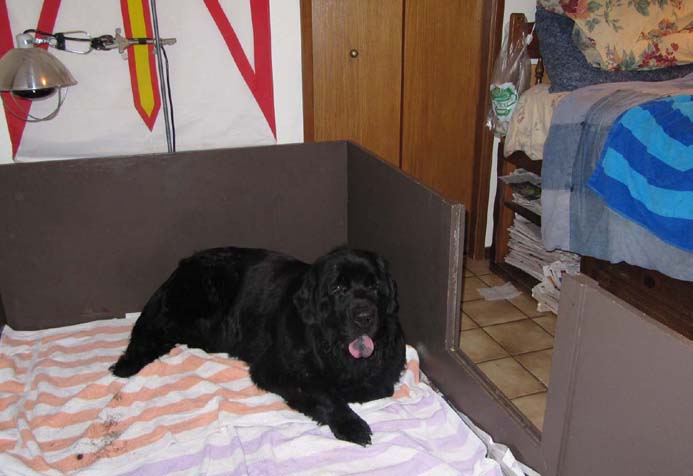
Chapter Two
Whelping
Sixty-three days. Nine short weeks. That’s the gestation period for dogs, the time span between getting pregnant and whelping the litter. To a breeder, and to the families waiting for their puppy to be born, those nine weeks seem to drag by, as slowly as molasses. But all too soon, the mother-to-be starts showing those unmistakable signs. And one by one, those lovely Sweetbay puppies arrive in the world.

Thirty years ago, when Ellis and Judi built their house, they designed a room specifically for birthing puppies. A large wooden whelping box takes up most of the floor space. A raised captain’s bed (for human sleeping) is high off the ground, so the pregnant or newly-delivered bitch can’t take up residence, too. Big closets hold whelping supplies, and a television and microwave add to the humans’ comfort. Once the mom understands that she won’t be allowed to whelp in her chosen dirt cave outside, she welcomes the whelping box. Starting a day or two before she whelps to at least two weeks after, Judi or Ellis are in residence in the whelping room, full-time, day and night. Sweetbay moms are excellent whelpers and puppy raisers, and the continuous low-key observation by Judi and Ellis just confirms that everything is going well.
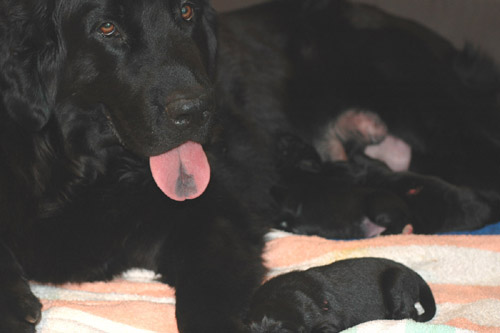
Giving birth is joyous – and private. It’s also considerably gentler than human birthing. Sometimes, a puppy will slide forth into the world with very little outward clue from the mom. Observant breeders develop a sixth sense about whelping. They know when all is well, and when intervention is needed. Fortunately, bitches with a good genetic reproductive background rarely need help. And how do the Adlers know when all the pups have been delivered? The whelping mom tells them. A bitch who has more pups yet to come will remain awake and alert. She knows her business is unfinished.
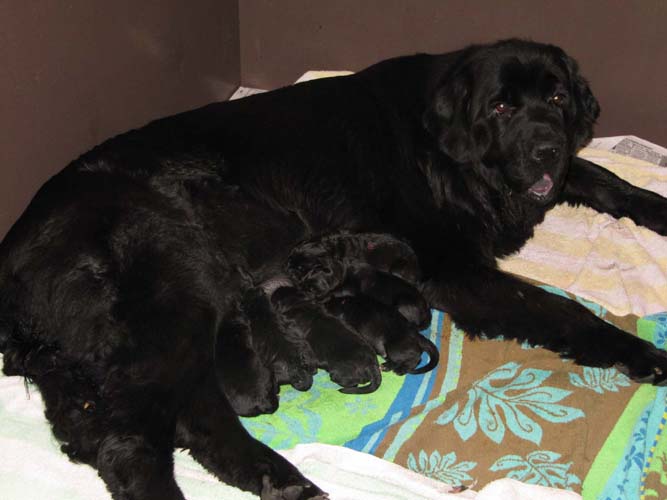
As each baby is born, Judi and Ellis take over. The puppy’s umbilical cord is tied off and cut and the placenta is disposed of. He gets a thorough towel drying. Then his sex and weight are noted on a chart, along with any other pertinent information about his arrival. He also gets his own identifying mark, a nickname, and a color designation. This confirms that he is not just a puppy but an individual. Once Judi and Ellis’ tasks are completed, the mom takes over again, snuggling the puppy and offering him his first milk meal. These first nursing sessions provide colostrum, which protects the puppies. Nursing also stimulates contractions, which help the still-in-utero pups to be born.
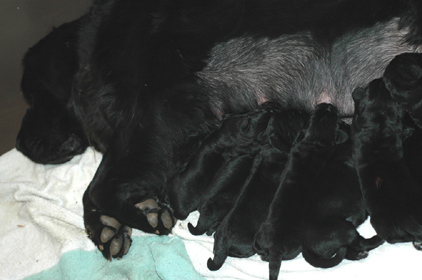
There’s no mistaking a mother who has finished giving birth. It might have taken her four hours – or fourteen. But when she’s done, she is ready for a serious nap. With her pups happily feeding, she sinks into welcome sleep.
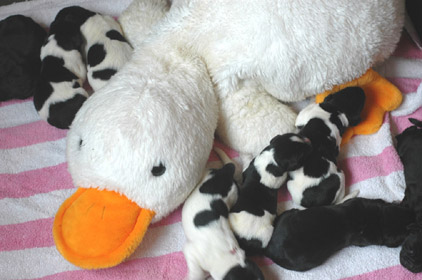
Each pup is weighed daily and monitored at all times, to be sure that each one gets enough to eat and that everyone is doing fine. But Newfie puppies often look identical, so how will you tell them apart?
Every good breeder has a way to distinguish one puppy from another. At Sweetbay, nail polish (renewed every few days) does the trick. First-born pups are marked on the top of their heads; second-borns on their right shoulders, and so on. Landseer puppies have distinctly different markings, but they get a nail-polish splotch, too. It’s easy to confuse one puppy with another, but the paint splash makes sure that never happens.
The nicknames are both helpful and fun. At Sweetbay, there is a theme to each litter, and visitors have a great time trying to guess what it is. But the nicknames are convenient as well as cute. It’s much easier to report that “Casey” is doing such-and such than “The puppy with the paint on the middle of his back …”__
A wall chart is posted in the whelping room, listing each puppy (in birth order) by name, by his marking, and by his designated color. When visitors come, Judi slips stretchy terry-cloth bands around each puppy’s neck. Rick-rack and ribbon proved unsatisfactory, so Judi came up with this better idea. She sewed over a hundred terry-cloth circlets, much like tennis sweat bands. The collection features a dozen colors, and each color comes in several sizes, which fit tiny newborns on up to eight-week-old pups. The green pup has a green neckband, the blue wears blue, and so on.
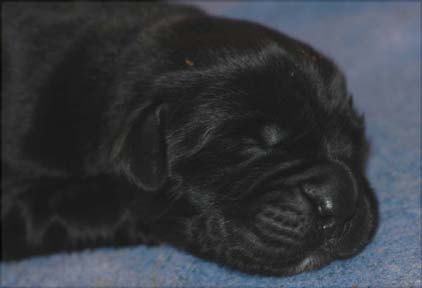
Newborn puppies’ eyes are sealed shut. Their ears are sealed shut, too. At this age, they cannot see or hear. Their eyes and ears won’t start functioning until around day twelve or so.
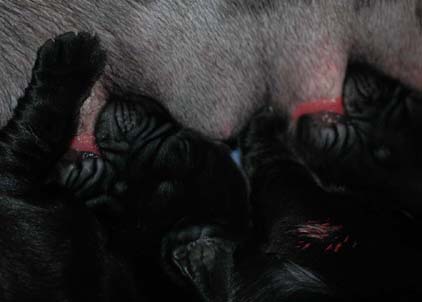
Fortunately, they have amazing noses, and they have no problem locating their mom’s mammary area. Those pink puppy tongues are cleverly designed. Newborn tongues have jagged edges, like someone used a miniature pinking shears around the rim. The serrated edges allow the pups to grip the nipple and achieve suction. A strong nurser adheres like a limpet. It takes real effort to pop him loose - especially if he isn’t ready to quit.
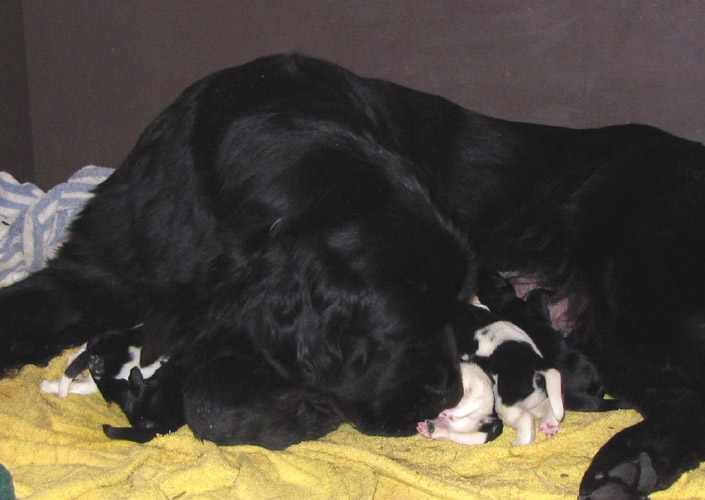
Newborns cannot pee or poop on their own. That’s where their mom comes in. She licks them in the appropriate area, stimulating elimination – and then cleans them up when they are done. And she magically knows, just by sniffing each one, which puppies need her attention. If the mother lacks maternal instincts and refuses to clean her pups, the breeders must do this, many times a day – or the puppies will die. You can see why having good reproductive instincts in their dogs is so valuable to a breeder.
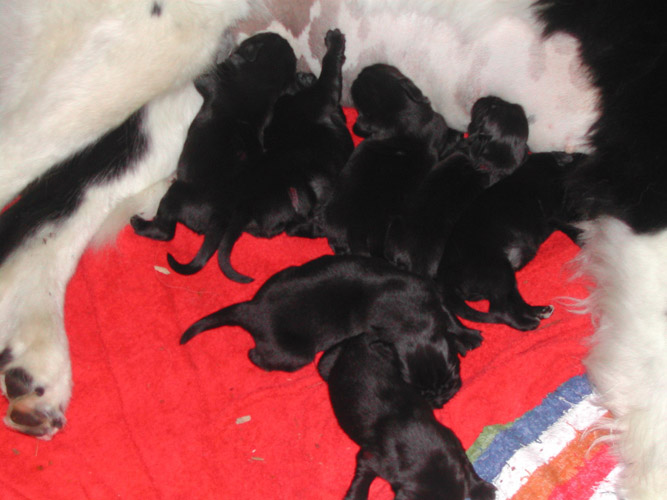
Strong, healthy puppies nurse avidly. When they’re full, they crawl away and find a comfortable place to sleep. Unlike most breeds, Newfie pups get too hot nestled up against mom’s teats, so they head for cooler climes.
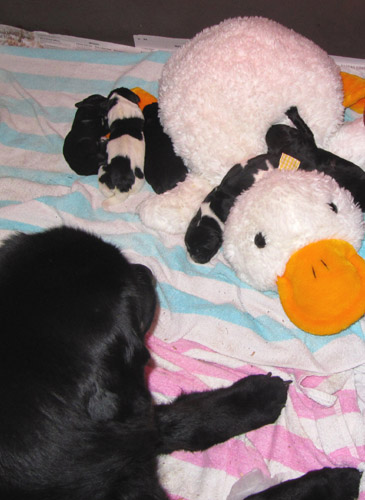
The Adler whelping box always features at least one large stuffed animal. It might be a duck, a cow, a bunny, or a bear. The stuffie provides a cuddly atmosphere without the heat their mom generates. Unerringly, when they finish feeding, the pups head for the stuffed animal and are soon fast asleep.
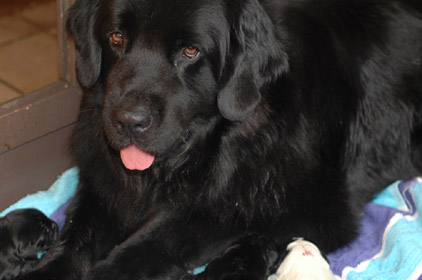
During the first week or so, even the most benevolent of Newfies turns protective. The mom may take up a spot at the doorway into the whelping box. She knows her pups are vulnerable, so she is alert at all times. Ellis and Judi are constant and welcome presences in the whelping room. But strange footsteps or voices in the house are stressful, and the mom goes on full alert. For this reason, the Adlers discourage visitors during the first week.
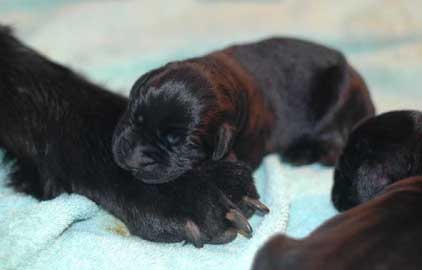
Pups generally weigh between a pound and a pound and a half at birth. They are about the size of a hefty baked potato.
If you look closely, you can spot the dirt on mom’s toenails. She’s been constructing the outdoor cave she intended as her whelping spot, the one that Judi and Ellis vetoed. She has already whelped her puppies. But she’s still digging, because that’s what her reproductive instincts tell her to do.
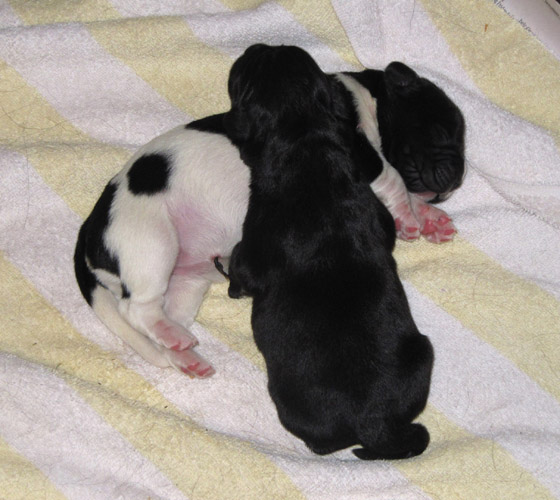
The puppies use each other as comfy pillows. They look like interlocking Lincoln logs as they drape themselves over each other.
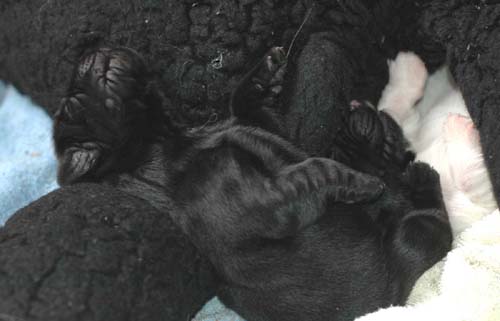
There’s always one in every litter: the guy who finds the most comfortable spot on the stuffed toy and promptly makes himself at home.
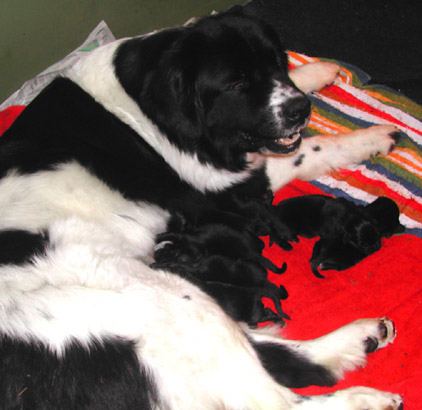
Instinctive mothers know when all is right with the litter. Contented pups, contented mom. And contented breeders!